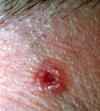Skin Cancer Flashcards
(44 cards)
What are the main types of skin cancer?
Melanoma and non-melanoma (Basal cell and squamous cell)
Which cells and layers do non-melanoma cancers arise from?
Keratinocytes (in the basal layer for BCC, and supra basal layers for SCC)
Which cells and layer does melanoma arise from?
Melanocytes in the basal layer
What is the most serious skin cancer?
Melanoma
What is the most common skin cancer?
Basal Cell Carcinoma
What does prognosis depend on?
Tumour depth (Breslow’s Depth) and ulceration
A depth more than ? indicates poor prognosis, as likely to have spread?
4mm (and >1mm has an excellent prognosis)
ABCDE of skin cancer diagnosis
Asymmetry, Borders, Colour, Diameter and Evolution
Ugly Duckling Sign
The observation that nevi in the same individual tend to resemble one another, and that malignant melanoma often deviates from this nevus pattern
What kind of cancer are rodent ulcers associated with?
Basal CC
‘Non-pigmented pearly appearance with rolled edge’

Basal CC
‘Hyperkeratotic (crusted) lump/ulcer on sun-damaged area of skin’

Squamous CC
Main examples of precursor lesions
Actinic keratoses and Bowen’s disease
What are main risk factor for skin cancer?
Sun exposure, skin type (I-III), genetic predisposition, immunosuppression, HPV infection, and other environmental carcinogens
Which cancer tends to be associated with chronic, cumulative UV exposure?
Squamous CC
Which cancer tends to be associated with intermittent, intense sunburn episodes?
Basal CC and melanoma
What is Xeroderma pigmentosum (XP)?
A very rare skin disorder where a person is highly photosensitive, has premature skin aging and is prone to developing skin cancers. This is caused by a cellular hypersensitivity to ultraviolet (UV) light as a result of a defect in the DNA repair system
What is Naevoid Basal cell syndrome (Gorlin’s syndrome)?
Autosomal dominant familial cancer syndrome due to mutation in PTCH 1 gene (a tumour suppressor). Results in multiple and early onset of BCC.
What are the symptoms of Naevoid Basal Cell Syndrome?
• early onset/multiple BCCs • palmar pits • jaw cysts • calcification fax cerebri
What is Recessive dystrophic epidermolysis bullosa (RDEB)?
Rare inherited blistering disease where the site of blister formation is the lamina densa within the basement membrane zone and the upper dermis. “Butterfly babies”. - The main mutation is hereditary type VIII collagen deficiency
‘Transplant hands’
People who have received a transplant are more likely to get SCC due to their immunosuppression. They have accelerated progression from AK to SCC. This commonly occurs on the hands
What is the definition of cancer?
An accumulation of abnormal cells that multiply through uncontrolled cell division and spread to other parts of the body by invasion and/or distant metastasis via the blood and lymphatic system
What is clonal evolution of cancer?
A series of mutations accumulating in successive generations of cells, resulting in cancer

What are the 6 hallmarks of cancer cells, by definition?
1) Evading growth suppressors 2) Activating invasion and metastases 3) Enabling replicative immorality 4) Inducing angiogenesis 5) Resisting cell death 6) Sustaining proliferative signalling (plus 2 enabling and 2 emerging hallmarks)




